Composition, benefits and harms of broccoli
Broccoli is a green superfood, as it is called in the West. This nutritious cabbage is beneficial for the gastrointestinal tract, cardiovascular system, and has antioxidant and antitumor properties. Let's talk about the vegetable as a valuable dietary product, its chemical composition, benefits and main contraindications.
What is broccoli
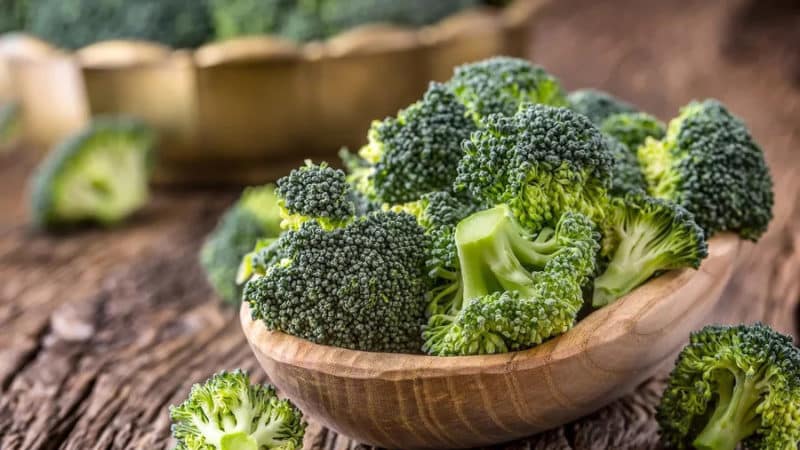
The name “broccoli” has Italian roots, literally meaning “flowering stem of cabbage.” Translated from Latin, bracchium means “branch.”
Reference. Broccoli was successfully grown by the ancient Romans in the 6th-5th centuries. BC e. Europe learned about this vegetable only in the 16th century. In England, the plant gained recognition 200 years later; here it was called Italian asparagus. They began to actively cultivate the crop in America, Spain, and Russia in the 30s of the 20th century.
Broccoli is a vegetable plant, an annual, a variety of cabbage of the huge Cruciferous family (Brassicaceae, or Brassicas). In scientific gradations, it is believed that broccoli is the genetic “progenitor” cauliflower.
What does broccoli look like?
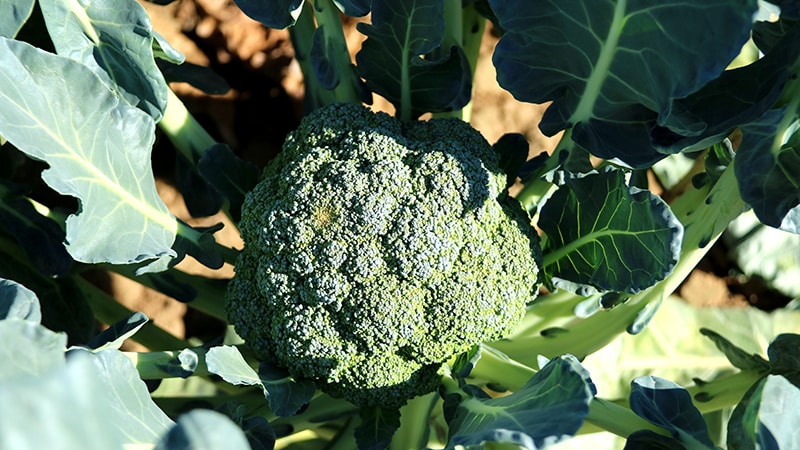
The dense stem stretches up to 70–90 cm in height over the course of a season. It is thick and powerful, forms a large number of strong succulent branches-peduncles.
At the top of the peduncles, small bright green buds form in groups. At the very beginning of formation, they gather into a loose head and then bloom. The flowers are small yellowish. The biological features of broccoli are visible in the photo.
Dark emerald inflorescences are pressed tightly against each other and have a special taste and aroma of vegetable freshness. The stalk is also used for food.
Attention! Cut off the inflorescences before flowering. Blooming bright yellow broccoli is unsuitable for food.
Important conditions for agricultural technology are sufficient moisture and sun. The optimal air temperature is up to +20…+23°C.
Under favorable conditions, the head grows in diameter up to 15–17 cm, depending on the hybrid or subspecies. When the central head is cut off, new lateral buds are formed. Cabbage generously shares the harvest throughout the season (3-4 months in a row).
The health benefits and harms of broccoli
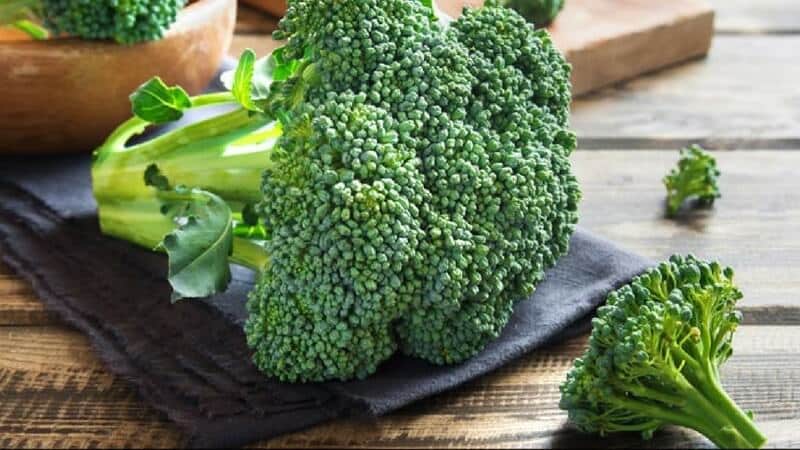
The benefits of broccoli have been proven by many studies in world medicine. Fresh green inflorescences and stems resist:
- development of atherosclerosis, formation of cholesterol plaques;
- chronic inflammation that damages the walls of blood vessels;
- pathologies of the stomach and duodenum;
- inflammatory processes in the body (pain in the joints and spine, bleeding gums).
Medicinal properties
All bred varieties of broccoli are high in nutrients. Sulforaphane, derived from glucoraphanin, protects the gastrointestinal mucosa from oxidative damage caused by the spiral-shaped bacteria Helicobacter pylori. The substance has anti-inflammatory properties, and its antitumor effect is being actively studied. Moreover, broccoli is ahead of Brussels and Savoy sprouts in terms of the amount of sulforaphane; seed sprouts are especially rich in it.
Vitamin K is involved in platelet aggregation, is responsible for hematopoiesis, blood clotting, healing and integrity of the skin and mucous membrane.
Interesting! 100 g of broccoli contains 85% of the daily requirement of vitamin K, cauliflower - 13%, white cabbage - 63%, Brussels sprouts - 208%.
Dietary fiber removes toxins and excess fluid, relieves constipation.
Vitamin C is a source of strength and energy, a natural antioxidant - supports the body's protective functions, resists inflammation and infections. 100 g of broccoli contains 99% of the daily requirement of ascorbic acid.
Diet rich in broccoli glucoraphanin (young plants and seedlings), reduces the amount of LDL in the blood plasma by 5–7% versus 2–3% for standard adult cabbage. It is low-density lipoproteins that are associated with the development of atherosclerosis.
Carotenoids-xanthophylls (lutein and zeaxanthin) support the health of the visual organs, resist cataracts, destruction of the retina, and maintain visual acuity.
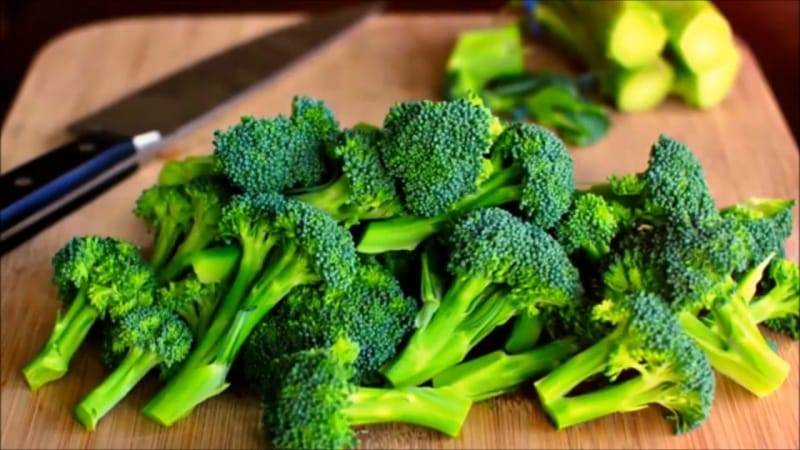
Contraindications
The product has no direct contraindications; no adverse reactions have been recorded with moderate consumption.
Due to its low calorie content, broccoli is included in the diet of overweight, obese people, people with heart problems, blood vessels, and high blood pressure.
Reference. Fasting days with vegetables are practiced; the main side dish is replaced with broccoli stew, which is boiled or baked.
The main rule is not to exceed the daily requirement: up to 200 g of finished product for an adult.
With caution and under the supervision of a doctor, steamed or blanched cabbage can be included in the diet for chronic pathologies:
- intestinal diseases;
- pancreatitis;
- increased stomach acidity;
- signs of individual intolerance to the vegetable;
- seasonal or food allergies.
It is recommended to use cabbage in food for medicinal purposes only in its raw form. It can be blanched or steamed. During prolonged heat treatment, a significant part of the nutrients is lost.
For children, the elderly and people with pathologies of the digestive tract, nutritionists advise pouring the inflorescences with hot water for 20–30 minutes before consuming. Without heat treatment, the cabbage will become softer, the color will be brighter, and the taste will be better.
It is important to choose the right broccoli:
- stems uniform dark green color;
- young cabbage, not overripe;
- without the smell of rot, mold and dark or yellowish fragments;
- dense inflorescences.
Conditions storage:
- fresh inflorescences are placed in water for 12 hours;
- when frozen, they are disassembled into parts, washed and dried, and packaged in containers or plastic bags in portions.
It is forbidden to defrost vegetables several times - beneficial features he doesn't save them.
Nutritional value and composition of broccoli
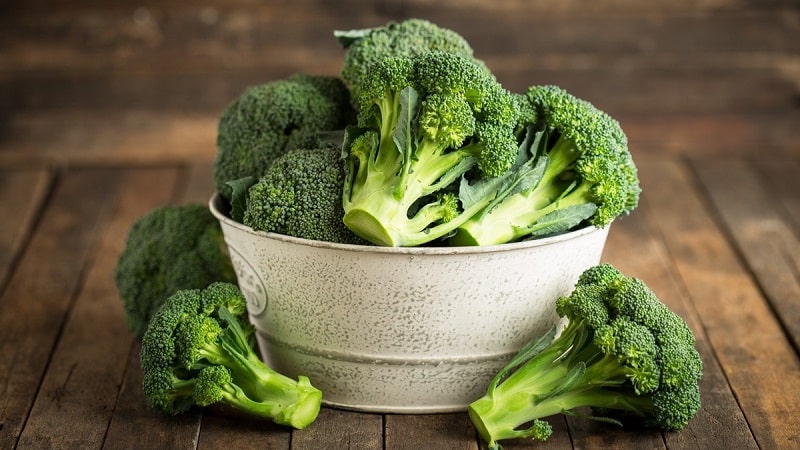
The calorie content and chemical composition of broccoli change:
- insignificantly, within 5–10 units, depending on varieties, growing conditions, climate, soil fertility;
- by 20–50 units depending on the cooking method (adding butter, broth, marinade, creamy or sour cream sauce);
- Nutrients are significantly lost (by 50%) during long-term storage and transportation of fresh vegetables, repeated defrosting, or improper freezing.
Calorie content
100 g of fresh cabbage contains 30–34 kcal. The nutritional value of the product is completely preserved during shock (immediate) freezing. Inflorescences and stems treated with boiling water without heat treatment lose beneficial substances by 4-5%.
Whether boiled or stewed, broccoli cooked in the microwave does not lose its taste, retains its density and bright, rich color. The calorie content of the finished product is slightly reduced to 25–27 calories per 100 g.
Assorted pickled cabbage marinated with sugar, vinegar and spices increases calorie content by 10 units.
Inflorescences fried in butter are high in calories, so they are not considered healthy and dietary dish. It is better to season the salad or boiled side dish with vegetable (corn or olive) oil.
BJU in broccoli
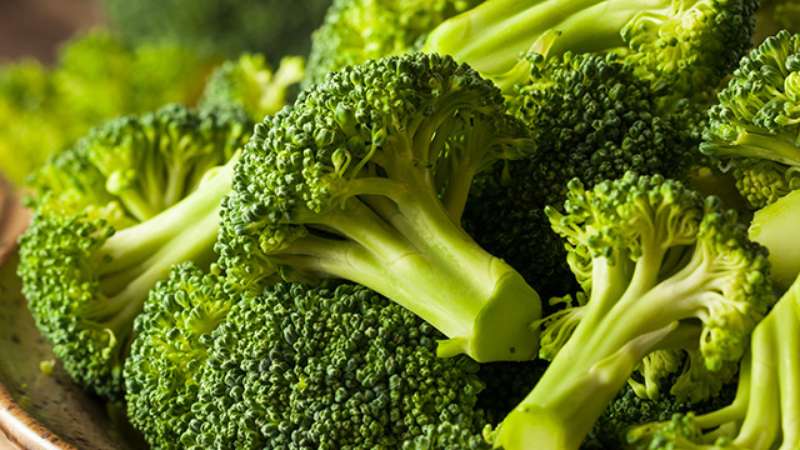
In fresh and frozen form, the ratio of proteins, fats and carbohydrates per 100 g of product is 38.4%, 7.6%, 54%. From the daily norm in grams - 3.29, 0.65, 4.6, respectively.
Stewed or baked inflorescences without salt practically do not change their properties. BJU ratio (in grams) - 2.4, 0.42, 6.1.
Boiled without added salt - 2.39 g of proteins, 0.41 g of fat, 3.89 g of carbohydrates. With moderate addition of salt, the indicators do not change.
The marinade contains 2.4 g of protein, 0.42 g of fat and 3.9 g of carbohydrates per 100 g of product.
Vitamins and other elements
The chemical composition of broccoli is varied. With a low calorie content, proteins and fiber predominate.
100 g of raw cabbage contains:
- more than 11.2% dry matter;
- up to 3.8% sugar depending on the variety and growing conditions;
- 0.4% starch;
- 7–13% fiber (indigestible coarse fiber);
- more than 4.5% protein.
100 g of fresh inflorescences contain:
- up to 90 mg of ascorbic acid;
- more than 1400 mcg of lutein and zeaxanthin;
- 0.07 mg thiamine (B1);
- 0.12 mg riboflavin (B2);
- 0.64 mg niacin (PP);
- 18.7 mg choline (B4);
- 0.57 mg pantothenic acid (B5);
- 0.18 mg pyridoxine (B6);
- up to 66 mcg of folate (B9);
- 0.78 mg alpha-tocopherol (E);
- 0.5 mcg biotin (H);
- 102 mcg phylloquinone (K);
- 9.1 mg vitamin U.
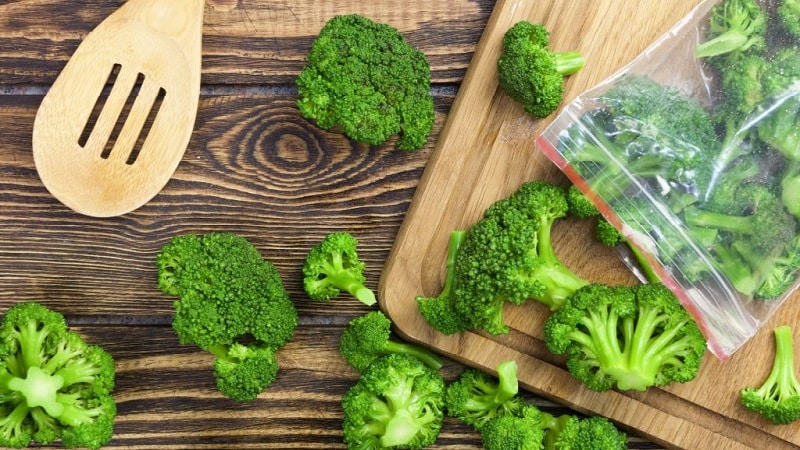
There are 17 micro- and macroelements per 100 g of vegetable:
- 316 mg potassium;
- 47 mg calcium;
- up to 80 mg silicon;
- 21–25 mg magnesium;
- 33 mg sodium;
- 140 mg sulfur;
- up to 68–70 mg phosphorus;
- 575 mcg aluminum;
- 185 mcg boron;
- 0.73 mg iron;
- 15 mcg iodine;
- 0.22 mg manganese;
- 50–70 mcg copper;
- 9 µg nickel;
- up to 3 mcg selenium;
- up to 2 mcg chromium;
- up to 0.6 mg zinc.
The fresh above-ground part of broccoli contains useful (digestible) carbohydrates:
- 1.7 g mono- and disaccharides;
- 0.5 g glucose;
- 0.68 g fructose.
Essential and non-essential amino acids contained in broccoli support the functioning of the endocrine glands, ensure normal functioning of the liver, regulate metabolic processes, provide energy, increase performance and endurance.
100 g of broccoli contains:
- 0.2 g arginine;
- up to 0.14 g of valine, lysine and leucine;
- 0.06 g histidine;
- 0.08 g isoleucine;
- up to 0.07 g of methionine and tryptophan;
- 0.09 g threonine;
- 0.1 g alanine;
- 0.33 g aspartic acid;
- 0.09 g glycine;
- 0.54 g glutamic acid;
- up to 0.12 g of proline and serine;
- 0.05 g tyrosine;
- 0.03 g cystine;
- 0.17 g phenylalanine.
Broccoli contains saturated, mono- and polyunsaturated fatty acids, participants in metabolic processes in the body:
- 0.01 g stearic;
- 0.05 g palmitic;
- 0.03 g omega-9;
- 0.02 g omega-3;
- 0.02 g omega-6.
One average head weighing 608 g contains 904% of the daily value of ascorbic acid, 772% of vitamin K, 96% of B9, 55% of potassium, 40% of phosphorus, approximately 30% of magnesium and calcium, 25% of iron.
Conclusion
Over the past decade, the popularity of broccoli has increased tenfold in India, Turkey, Italy, China, Spain, Israel and America. According to statistics, up to 45% of the total world harvest of this vegetable is harvested in these countries.
Vitamins and minerals in cabbage ensure metabolism.Beneficial substances resist the formation of cholesterol plaques, protect the heart and blood vessels, and prevent strokes and heart attacks. Broccoli protects the mucous membrane of the digestive tract from pathologies and is equally useful for children and adults.